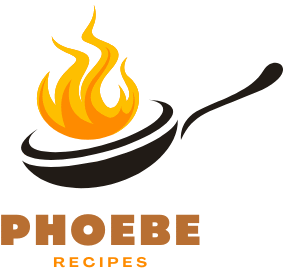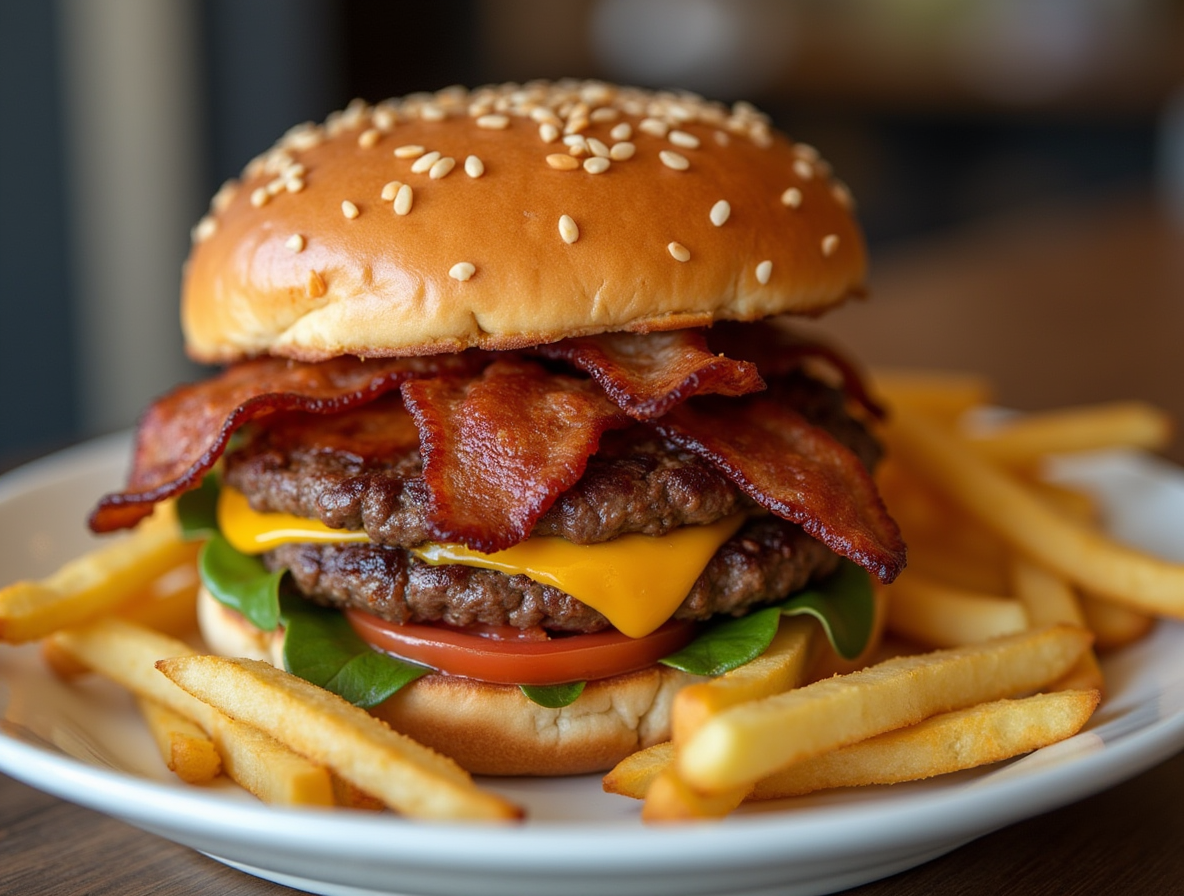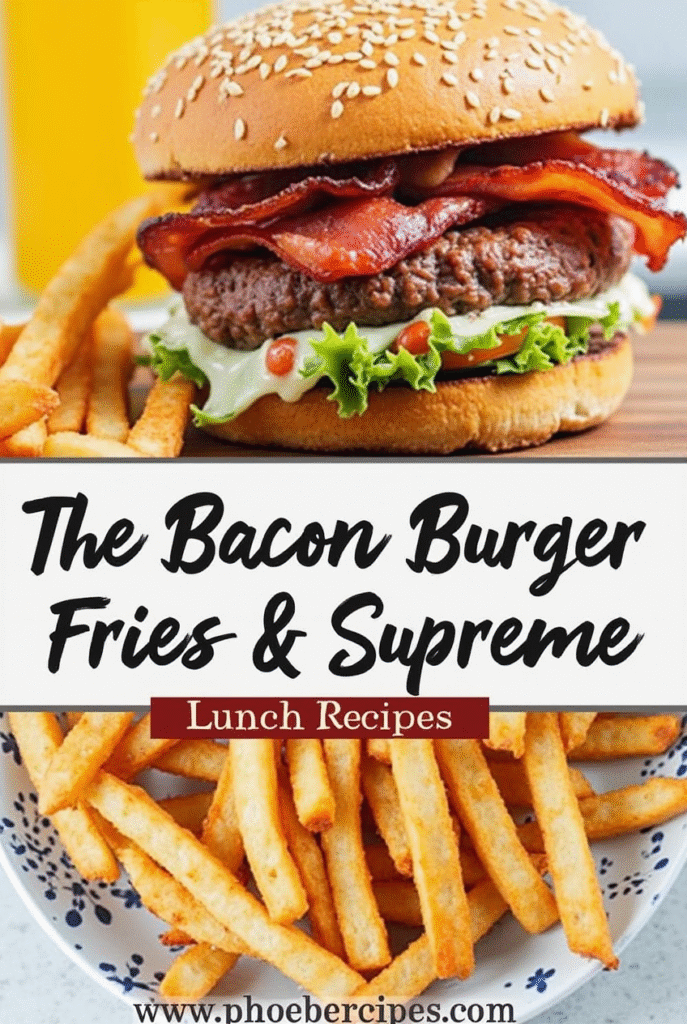How to Make the Perfect Bacon Cheeseburger with Fries: Secret Restaurant Method
Bacon cheeseburger with fries has been a beloved American classic for decades, with establishments like Burgers Supreme proving its staying power as a Utah County staple for over 29 years. Fresh ingredients are undoubtedly the foundation of any great burger, but the secret to restaurant-quality results lies in specific techniques that most home cooks overlook.
We’ve perfected our bacon cheeseburger recipe through years of testing, discovering that the right balance of ingredients makes all the difference. For instance, using 80% lean ground chuck creates juicier patties than leaner alternatives, while proper bacon selection dramatically impacts the final flavor. When paired with perfectly crispy fries, which can be baked at 450°F for 50-60 minutes or air-fried at 400°F for about 40 minutes, this combination becomes an irresistible meal. Additionally, our cheese burger fries variation offers a healthier twist with 96% lean beef and thoughtfully selected condiments like sugar-free ketchup and light mayo.
In this guide, I’ll share the professional methods that transform an ordinary bacon burger into a restaurant-worthy masterpiece—all achievable in just 35 minutes from prep to plate.
Choosing the Right Ingredients for Flavor and Texture
Creating a restaurant-quality bacon cheeseburger starts with selecting ingredients that deliver both flavor and the perfect texture. The right combination makes all the difference between an ordinary burger and a mouthwatering masterpiece.
Best ground beef for juicy patties
For truly juicy bacon cheeseburgers, ground chuck with an 80/20 lean-to-fat ratio is essential. This ideal balance provides enough fat to keep your patties moist and flavorful without becoming greasy. Fresh ground beef from a butcher (rather than pre-packaged tubes) creates more tender patties since it hasn’t been compacted. Furthermore, look for packages with bright rosy-pink color, which indicates freshness. The combination of brisket, chuck, sirloin, and tenderloin creates exceptional flavor, though plain ground chuck works wonderfully for a classic burger experience.
Why bacon cut matters
Regular-cut bacon is preferable for bacon cheeseburgers because it cooks up crispy without becoming too chewy. Thick-cut bacon, while meatier, can become difficult to bite through on a burger, forcing diners to “wrangle with chewy bacon”. Cook bacon until it’s browning but not completely crunchy, as it will continue cooking when placed on the hot burger. Notably, cooking bacon in advance and cutting it in half makes for easier burger assembly.
Choosing the right cheese for melt and flavor
Medium sharp cheddar offers the perfect balance of flavor and meltability for a classic bacon cheeseburger. American cheese provides excellent melt, whereas aged cheddar delivers stronger flavor but can be too crumbly. For optimal melting, use square slices slightly larger than your patties. A professional technique is placing two cheese slices offset by 45 degrees, creating an eight-point star that allows cheese to cascade evenly around the burger.
The role of fresh toppings
Fresh toppings balance the richness of your bacon cheeseburger. Green leaf lettuce is superior to romaine, which has a thick vein that disrupts the burger’s texture. Beefsteak tomatoes are ideal as they’re wide yet not overly juicy, preventing soggy buns. Essentially, fresh ingredients bring necessary balance to the savory, rich components of your burger.
Picking the perfect buns
Brioche buns reign supreme for bacon cheeseburgers with their slight sweetness complementing smoky bacon flavors. Their soft yet sturdy texture holds up to juicy patties without getting soggy. Martin’s Potato Rolls are another excellent option, especially popular on the East Coast. Regardless of which you choose, toasting the buns is crucial—preferably in bacon fat for extraordinary flavor. This creates a barrier against moisture while adding another layer of deliciousness to your bacon cheeseburger.
Making Crispy Fries Like a Pro
The perfect companion to your bacon cheeseburger is a batch of restaurant-quality french fries with a crispy exterior and fluffy interior. Mastering this side dish requires understanding key techniques that restaurants use to achieve consistent results.
Oven vs. air fryer: which is better?
Both methods have distinct advantages for homemade fries. Air fryers produce consistently crispier results with a golden exterior in less time than conventional ovens. In side-by-side tests, air fryer fries achieved a 5/5 star rating compared to oven-baked fries’ 4/5 stars due to superior crispiness and flavor. Moreover, air fryers require minimal preheating, further reducing total cooking time. However, conventional ovens accommodate larger batches, making them better for serving groups. For the best middle ground, convection ovens with air fry capabilities offer similar results to standalone air fryers with more cooking space.
How to cut and season fries
Russet or Idaho potatoes are ideal for french fries due to their high starch and low moisture content. First, cut potatoes into uniform ¼-inch thick batons using a serrated knife to create micro-roughness on the surface—a secret trick for extra crispiness. After cutting, soak the fries in cold water with a tablespoon of lemon juice to prevent discoloration and rinse until the water runs clear to remove excess starch. For seasoning, combine 1 teaspoon each of table salt, onion powder, garlic powder, and paprika with ¼ teaspoon each of dried oregano, parsley, cayenne pepper, and black pepper for restaurant-quality flavor.
Tips for extra crispy texture
The restaurant secret to exceptional crispiness is the double-fry method. Initially, blanch the fries at a lower temperature (around 325°F) for 5-7 minutes to cook the interior without browning the exterior. Then, after cooling, fry again at a higher temperature (375°F) for 2-3 minutes until golden and crispy. Alternatively, simmer cut potatoes for 10 minutes in vinegar-water (one tablespoon per quart) before frying—this strengthens the pectin structure for ultimate crispiness without affecting flavor.
Oil and temperature control
Temperature control is crucial for perfect fries. Choose oils with high smoke points like peanut, canola, or avocado oil. For the double-fry method, maintain precise temperatures: 325°F for the first fry, then 375°F for the second. Interestingly, slightly used oil produces crispier fries than brand new oil—restaurants achieve consistent results by reusing oil within safe limits. Always use a thermometer for accuracy; temperature fluctuations lead to greasy or undercooked fries.
Cooking and Assembling the Bacon Cheeseburger
The assembly process transforms ordinary ingredients into a restaurant-worthy bacon cheeseburger with fries. With precise techniques, you’ll achieve that elusive balance of crispy, juicy, and melty elements that define professional results.
How to cook bacon for maximum crisp
Baking bacon delivers consistently crispy results every time. Preheat your oven to 400°F, line a baking sheet with parchment paper, and arrange strips without overlapping. For extra crispiness, dredge bacon strips in all-purpose flour, shake off excess, and refrigerate overnight before baking for 15-20 minutes. This flour coating jump-starts browning while minimizing spattering.
Smashing vs. shaping burger patties
For smash burgers, place golf ball-sized meat portions on a hot surface, cook for about 20 seconds, then flip and smash firmly. This creates a delicious crust while keeping juices intact. Alternatively, shape patties with a shallow dimple in the center to prevent bulging. The winning method uses deli container lids as gentle presses, creating patties that cook evenly with minimal shrinking.
Melting cheese the right way
Place cheese on the patty about one minute before it finishes cooking. Next, add a few splashes of water to the pan and immediately cover with a tight-fitting lid. The steam melts cheese perfectly in about 30 seconds without making it slide off. This technique works best in a skillet or griddle rather than an open grill.
Layering ingredients for the perfect bite
Proper stacking creates structural integrity and optimal flavor. From bottom up: toasted bun, condiment, lettuce (creates juice barrier), tomato, patty with melted cheese, bacon (secured by the melted cheese), onions, and top bun with condiment. This arrangement prevents soggy buns and keeps toppings from escaping.
Toasting buns with mustard for extra flavor
For an extraordinary flavor boost, spread mustard on bun halves and place them mustard-side down in a hot pan. The mustard caramelizes as it toasts, creating a tangy-sweet foundation that elevates your bacon cheeseburger to restaurant quality. One tablespoon of butter in the pan ensures golden, crispy edges.
Final Touches and Serving Tips
The difference between homemade and restaurant-quality bacon cheeseburgers often comes down to the final touches and serving techniques. These finishing details elevate your meal from merely tasty to genuinely impressive.
How to keep fries crispy under toppings
Moisture and heat loss are the enemies of crispy french fries. For maximum crispiness, use paper or cardboard packaging with ventilation holes large enough for adequate airflow but not so large that fries get cold. Alternatively, place fries on a wire rack instead of paper towels after frying, allowing air to circulate around them. Prior to serving, line containers with paper towels to absorb excess moisture—towels below absorb oil while those above catch rising vapors.
Adding burger sauce without sogginess
Always start with lettuce on the bottom of your burger. This creates a crucial barrier between the bun and juicy toppings, preventing soggy bread. Subsequently, add heartier vegetables like tomato and onion slices before the patty and cheese. For sauces, either slather them onto the top bun only or serve them on the side. Although this might seem like a small detail, keeping sauces separate until serving significantly extends the crispiness of your bacon cheeseburger assembly.
Garnish ideas: pickles, chives, and more
Bread and butter pickle slices make perfect garnishes for bacon cheeseburgers. Secondly, consider serving pickles on the side to let guests customize their experience. Caramelized onions offer another restaurant-quality garnish option that adds sweetness to balance the savory bacon. Fresh herbs like chives or parsley sprinkled over the finished plate provide color contrast and brightness that makes your presentation pop.
Serving suggestions for a restaurant-style plate
For a professional presentation, liberally salt and pepper your burger patties to enhance meat flavor. Accordingly, use a cast iron skillet for cooking—it provides superior temperature control and creates the juicy, crispy texture that defines restaurant burgers. Finally, ensure your burger components are thoughtfully layered, with vegetables on the bottom bun and sauces applied strategically. This careful assembly results in a bacon cheeseburger with fries that looks and tastes like it came straight from a professional kitchen.
Conclusion
Making the perfect bacon cheeseburger with fries requires attention to detail throughout every step of the process. Certainly, selecting the right ingredients forms your foundation—80/20 ground chuck, regular-cut bacon, and brioche buns create that unmistakable restaurant quality. Additionally, mastering techniques like the double-fry method for crispy fries and proper cheese melting transforms ordinary meals into extraordinary ones.
Though it might seem overwhelming at first, these professional methods actually simplify your cooking process while dramatically improving results. The bacon flour-dredging technique, for instance, delivers consistently crispy bacon every time. Similarly, proper ingredient layering prevents soggy buns and creates structural integrity that holds your masterpiece together.
After trying these methods myself, I can confidently say they’ve revolutionized my home cooking. Consequently, friends and family now request my burgers instead of suggesting takeout. Most importantly, these techniques don’t require fancy equipment or culinary school training—just thoughtful application of professional secrets.
Last but not least, remember that presentation matters. A properly assembled bacon cheeseburger with perfectly crispy fries not only tastes better but also creates that restaurant experience right at your kitchen table. Therefore, take the extra minute to arrange your creation beautifully before serving.
Whether cooking for yourself or entertaining guests, these restaurant methods elevate an American classic into something truly special. Once you’ve mastered these techniques, you’ll never look at a bacon cheeseburger the same way again.
FAQs
Q1. What’s the best type of ground beef for juicy burger patties? For the juiciest burgers, use ground chuck with an 80/20 lean-to-fat ratio. This balance provides enough fat to keep your patties moist and flavorful without becoming greasy. Fresh ground beef from a butcher is preferable as it creates more tender patties.
Q2. How can I make my fries extra crispy at home? To achieve extra crispy fries, use the double-fry method. First, blanch the fries at a lower temperature (around 325°F) for 5-7 minutes. Then, after cooling, fry them again at a higher temperature (375°F) for 2-3 minutes until golden and crispy. Alternatively, soak cut potatoes in vinegar-water before frying to strengthen their structure.
Q3. What’s the secret to melting cheese perfectly on a burger? For perfectly melted cheese, place it on the patty about one minute before it finishes cooking. Add a few splashes of water to the pan and immediately cover with a tight-fitting lid. The steam will melt the cheese evenly in about 30 seconds without making it slide off.
Q4. How should I layer my burger ingredients for the best result? Start with a toasted bun, then add condiments, lettuce (to create a juice barrier), tomato, patty with melted cheese, bacon (secured by the melted cheese), onions, and finally the top bun with condiment. This arrangement prevents soggy buns and keeps toppings from escaping.
Q5. What’s a professional tip for enhancing burger bun flavor? For an extra flavor boost, spread mustard on bun halves and place them mustard-side down in a hot pan with a tablespoon of butter. The mustard caramelizes as it toasts, creating a tangy-sweet foundation that elevates your burger to restaurant quality.


